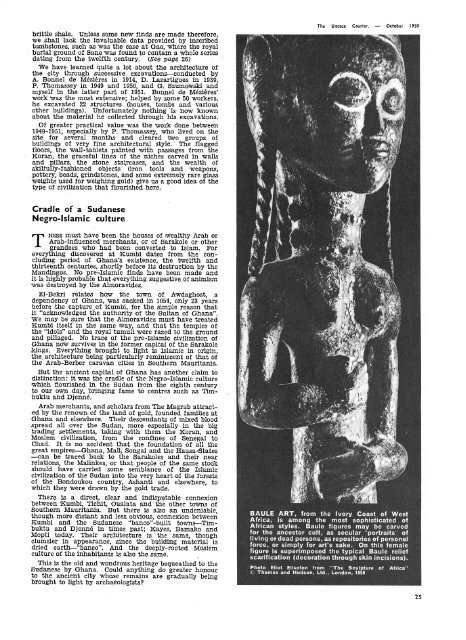Africa's lost past; the startling rediscovery of a ... - unesdoc - Unesco
Africa's lost past; the startling rediscovery of a ... - unesdoc - Unesco
Africa's lost past; the startling rediscovery of a ... - unesdoc - Unesco
Create successful ePaper yourself
Turn your PDF publications into a flip-book with our unique Google optimized e-Paper software.
ittle shale. Unless some new finds are made <strong>the</strong>refore,<br />
we shall lack <strong>the</strong> invaluable data provided by inscribed<br />
tombstones, such as was <strong>the</strong> case at Gao, where <strong>the</strong> royal<br />
burial ground <strong>of</strong> Sane was found to contain a whole series<br />
dating from <strong>the</strong> twelfth century. (See page 26)<br />
We have learned quite a lot about <strong>the</strong> architecture <strong>of</strong><br />
<strong>the</strong> city through successive excavations conducted by<br />
A. Bonnel de Mézières in 1914, D. Lazartigues in 1939,<br />
P. Thomassey in 1949 and 1950, and G. Szumowski and<br />
myself in <strong>the</strong> latter part <strong>of</strong> 1951. Bonnel de Mézières'<br />
work was <strong>the</strong> most extensive; helped by some 50 workers,<br />
he excavated 22 structures (houses, tombs and various<br />
o<strong>the</strong>r buildings). Unfortunately nothing is now known<br />
about <strong>the</strong> material he collected through his excavations.<br />
Of greater practical value was <strong>the</strong> work done between<br />
1949-1951, especially by P. Thomassey, who lived on <strong>the</strong><br />
site for several months and cleared two groups <strong>of</strong><br />
buildings <strong>of</strong> very fine architectural style. The flagged<br />
floors, <strong>the</strong> wall-tablets painted with passages from <strong>the</strong><br />
Koran, <strong>the</strong> graceful lines <strong>of</strong> <strong>the</strong> niches carved in walls<br />
and pillars, <strong>the</strong> stone staircases, and <strong>the</strong> wealth <strong>of</strong><br />
skilfully-fashioned objects (iron tools and weapons,<br />
. pottery, beads, grindstones, and some extremely rare glass<br />
weights used for weighing gold) give us a good idea <strong>of</strong> <strong>the</strong><br />
type <strong>of</strong> civilization that flourished here.<br />
Cradle <strong>of</strong> a Sudanese<br />
Negro-Islamic culture<br />
These must have been <strong>the</strong> houses <strong>of</strong> wealthy Arab or<br />
Arab-influenced merchants, or <strong>of</strong> Sarakole or o<strong>the</strong>r<br />
grandees who had been converted to Islam. For<br />
everything discovered at Kumbi dates from <strong>the</strong> con¬<br />
cluding period <strong>of</strong> Ghana's existence, <strong>the</strong> twelfth and<br />
thirteenth centuries, shortly before its destruction by <strong>the</strong><br />
Mandingos. No pre-Islamic finds have been made and<br />
it is highly probable that everything suggestive <strong>of</strong> aotiimism<br />
was destroyed by <strong>the</strong> Almorávides.<br />
El-Bekri relates how <strong>the</strong> town <strong>of</strong> Awdaghost, a<br />
dependency <strong>of</strong> Ghana, was sacked in 1054, only 23 years<br />
before <strong>the</strong> capture .<strong>of</strong> Kumbi, for <strong>the</strong> simple reason that<br />
it "acknowledged <strong>the</strong> authority <strong>of</strong> <strong>the</strong> Sultan <strong>of</strong> Ghana".<br />
We may be sure that <strong>the</strong> Almorávides must have treated<br />
Kumbi itself in <strong>the</strong> same way, and that <strong>the</strong> temples <strong>of</strong><br />
<strong>the</strong> "idols" and <strong>the</strong> royal tumuli were razed to <strong>the</strong> ground<br />
and pillaged. No trace <strong>of</strong> <strong>the</strong> pre-Islamic civilization <strong>of</strong><br />
Ghana now survives in <strong>the</strong> former capital <strong>of</strong> <strong>the</strong> Sarakole<br />
kings. Everything brought to . light is Islamic in origin,<br />
<strong>the</strong>, architecture being particularly reminiscent <strong>of</strong> that <strong>of</strong><br />
<strong>the</strong> Arab-Berber caravan cities in Sou<strong>the</strong>rn Mauritania.<br />
But <strong>the</strong> ancient capital <strong>of</strong> Ghana has ano<strong>the</strong>r claim to<br />
distinction: it was <strong>the</strong> cradle <strong>of</strong> <strong>the</strong> Negro-Islamic culture<br />
which flourished in <strong>the</strong> Sudan from <strong>the</strong> eighth century<br />
to our own day, bringing fame to centres such as Tim¬<br />
buktu and Djenné.<br />
Arab merchants, and scholars from The Magrab attract¬<br />
ed by <strong>the</strong> renown <strong>of</strong> <strong>the</strong> land <strong>of</strong> gold, founded families at<br />
Ghana and elsewhere. Their descendants <strong>of</strong> mixed blood<br />
spread all over <strong>the</strong> Sudan, more especially in <strong>the</strong> big<br />
trading settlements, taking with <strong>the</strong>m <strong>the</strong> Koran, and<br />
Moslem civilization, from <strong>the</strong> confines <strong>of</strong> Senegal to<br />
Chad. It is no accident that <strong>the</strong> foundation <strong>of</strong> all <strong>the</strong><br />
great empires Ghana, Mali, Songai and <strong>the</strong> Hausa^States<br />
can be traced back to <strong>the</strong> Sarakoles and <strong>the</strong>ir near<br />
relations, <strong>the</strong> Malinkes, or that people <strong>of</strong> <strong>the</strong> same stock<br />
should have carried some semblance <strong>of</strong> <strong>the</strong> Islamic<br />
civilization <strong>of</strong> <strong>the</strong> Sudan into <strong>the</strong> very heart <strong>of</strong> <strong>the</strong> forests<br />
<strong>of</strong> <strong>the</strong> Bondoukou country, Ashanti and elsewhere, to<br />
which <strong>the</strong>y were drawn by <strong>the</strong> gold trade.<br />
There is a direct, clear and indisputable connexion<br />
between Kumbi, Tichit, Oualata and <strong>the</strong> o<strong>the</strong>r towns <strong>of</strong><br />
Sou<strong>the</strong>rn Mauritania. But <strong>the</strong>re is also an undeniable,<br />
though more distant and less obvious, connexion between<br />
Kumbi and <strong>the</strong> Sudanese "banco"-built towns Tim¬<br />
buktu and Djenné in times <strong>past</strong>; Kayes, Bamako and<br />
Mopti today. Their architecture is <strong>the</strong> same, though<br />
clumsier in appearance, since <strong>the</strong> building material is<br />
dried earth "banco". And <strong>the</strong> deeply-rooted Moslem<br />
culture <strong>of</strong> <strong>the</strong> inhabitants is also <strong>the</strong> same.<br />
This is <strong>the</strong> old and wondrous heritage bequea<strong>the</strong>d to <strong>the</strong><br />
Sudanese by Ghana. Could anything do greater honour<br />
to <strong>the</strong> ancient city whose remains are gradually being<br />
brought to light by archaeologists? .<br />
The <strong>Unesco</strong> Courier. October 1959<br />
25

















